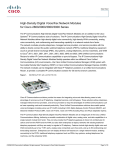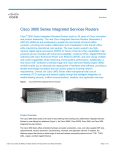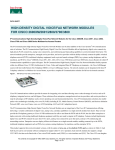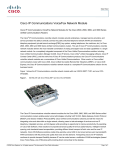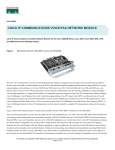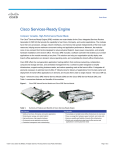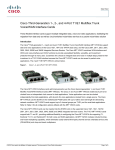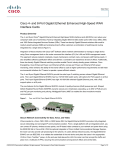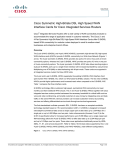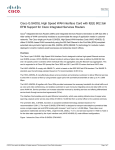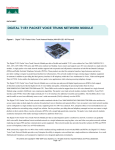Download Cisco High Density Analog/Digital Extension Module
Transcript
Data Sheet Cisco High-Density Analog and Digital Extension Module for Voice and Fax ® The Cisco High-Density Analog and Digital Extension Module for Voice and Fax (EVM-HD) provides enterprises, managed service providers and service providers the ability to directly connect publicswitched telephone networks (PSTNs) and existing telephony equipment to Cisco 2821, 2851, 2901, 2911, 2921, 2951, 3825, 3845, 3925, 3925E, 3945 and 3945E Integrated Services Routers. With support for up to 24 total voice and fax sessions, the Cisco High-Density Extension Module is ideal for networks with high analog (foreign exchange station [FXS], direct inward dialing [DID], and foreign exchange office [FXO]) and digital (Basic Rate Interface [BRI]) call-capacity requirements. Product Overview The Cisco High-Density Analog and Digital Extension Module for Voice and Fax (EVM-HD) is an industry-leading voice and fax interface module for Cisco 2821, 2851, 2901, 2911, 2921, 2951, 3825, 3845, 3925, 3925E, 3945 and 3945E Integrated Services Routers. It helps enable packet voice technologies with support for voice over IP (VoIP), including H.323, Media Gateway Control Protocol (MGCP) and Session Initiation Protocol (SIP). The Cisco HighDensity Extension Module allows Cisco 2821, 2851, 2901, 2911, 2921, 2951, 3825, 3845, 3925, 3925E, 3945 and 3945E Integrated Services Routers to connect directly to the PSTN and existing telephony equipment (for example, private branch exchange (PBX), Key system, analog telephones, and analog fax machines) through standard analog (FXS, DID, and FXO) and digital (BRI) interfaces. The High-Density Extension Module supports telephony toll bypass, new packet telephony applications, and full gateway integration. With support for up to 24 total voice and fax sessions, the Cisco High-Density Extension Module is ideal for networks with high analog and BRI call-capacity requirements; refer to Figure 1. Figure 1. Cisco High-Density Analog and Digital Extension Module for Voice and Fax The Cisco High-Density Extension Module includes the following components: ● An 8-port extension module (part number EVM-HD-8FXS/DID)-Baseboard with 8 ports that can be configured individually for FXS or DID signaling ● Voice and fax expansion modules: ◦ A 4-port expansion module supporting BRI (NT and TE) (part number EM-4BRI-NT/TE) ◦ An 8-port expansion module supporting FXS and DID (part number EM3-HDA-8FXS/DID) ◦ A 6-port expansion module supporting FXO (part number EM-HDA-6FXO) ◦ A 7-port expansion module with 3 FXS and 4 FXO ports (part number EM-HDA-3FXS/4FXO) © 2010-2013 Cisco Systems, Inc. All rights reserved. This document is Cisco Public Information. Page 1 of 9 Data Sheet Adding expansion modules to the Cisco High-Density Extension Module baseboard increases voice and fax session capacity. The modular design of the Cisco High-Density Extension Module provides maximum flexibility-plug in up to two expansion modules in any combination to build the Cisco High-Density Extension Module best suited for specific packet telephony network locations. The Cisco High-Density Extension Module provides gateway services for Cisco Unified Communications using Cisco Unified Communications Manager with Survivable Remote Site Telephony (SRST) or Cisco Unified Communications Manager Express (UCME). Gateway services allow users to deploy networks that take advantage of investments in existing legacy telephony equipment while also deploying and integrating IP telephony. The network can operate at any point on the voice, video and integrated data spectrum—with the ability to add connections for both traditional telephony devices and IP telephony endpoints. Cisco 2821 and Cisco 2851 Extension Voice Module Slot The Cisco High-Density Extension Module operates in the Extension Voice Module (EVM) slot on the Cisco 2821 and Cisco 2851 integrated services routers. The EVM slot supports additional voice services and density without consuming the network module slot on the Cisco 2821 or Cisco 2851. Cisco 3825 and Cisco 3845 Network Module Slot The High-Density Extension Module operates in any network module or enhanced network module (NME) slot on the Cisco 3825 and Cisco 3845 integrated services routers. The Cisco 3825 supports one Cisco High-Density Extension Module, and the Cisco 3845 supports one or two high-density extension modules. Cisco 2900 and Cisco 3900 Service Module Slot The Cisco 2900 and 3900 Series Integrated Services Routers support Network Modules and EVM Modules via an adapter (part number SM-NM-ADPTR). High-Density Extension Module Digital Signal Processor (DSP) Resources Packet voice DSP modules (PVDM2s) are used in combination with the Cisco High-Density Extension Module baseboard and its expansion modules. PVDM2s support multiple voice codecs, fax, conferencing, and transcoding services. PVDM2s are purchased separately and installed in the digital signal processor (DSP) module slots located inside the Cisco 2821, 2851, 2901, 2911, 2921, 2951, 3825, 3845, 3925, 3925E, 3945 and 3945E Integrated Services Routers. Initial orders for a Cisco 2821, Cisco 2851, Cisco 3825, or Cisco 3845 router that include a Cisco High-Density Extension Module should also include an appropriate number of PVDM2s. In addition to PVDM2, Packet voice DSP modules (PVDM3s) are also available for the same applications described above. PVDM3s are used in combination with the Cisco High-Density Extension Module baseboard and its expansion modules. PVDM3s support multiple voice codecs, fax, conferencing, and transcoding services. PVDM3s are purchased separately and installed in the digital signal processor (DSP) module slots located inside the Cisco 2901, 2911, 2921, 2951, 3925, 3925E, 3945 and 3945E Integrated Services Routers. Initial orders for a Cisco 2901, 2911, 2921, 2951, 3925, 3925E, 3945 and 3945E router that include a Cisco High-Density Extension Module should also include an appropriate number of PVDM3s. Note that PVDM3s are not supported on the ISRs. PVDM3s are supported only on the Cisco 2900 and 3900 series platforms. PVDM2 and PVDM3s can coexist on the Cisco 2900 and 3900 series platforms as long as both types are not installed on the motherboard at the same time. If PVDM2 are detected on the motherboard with PVDM3s, then PVDM2s will be deactivated, allowing only PVDM3s to be used. If PVDM2s are detected in SM slots and PVDM3s are installed on the motherboard, then both will continue to function and coexist. © 2010-2013 Cisco Systems, Inc. All rights reserved. This document is Cisco Public Information. Page 2 of 9 Data Sheet Applications Table 1 lists the Cisco High-Density Extension Module and expansion modules available and the applications each supports. Table 1. Cisco High-Density Extension Module Baseboard and Expansion Modules Product Number Description EVM-HD-8FXS/DID The Cisco High-Density Extension Module for voice and fax has 8 FXS and DID ports. Individual ports on the baseboard module can be configured for FXS or DID signaling. Adjacent ports should share the same configuration to avoid impedance setting conflicts. A change to the impedance setting for one port, changes the setting on the adjacent port. Paired ports are: 0 and 1; 2 and 3; 4 and 5; 6 and 7. An on-premises FXS interface connects directly to a standard telephone, fax machine, or similar device and supplies ring, voltage, and dial tone. Signaling support available in FXS mode includes loop-start and ground-start. DID trunks from the central office can be connected to the Cisco High-Density Extension Module baseboard for off-premises connections. Signaling support available in DID mode includes immediate, delay dial, and wink start. Users plug in up to two expansion modules in any combination to increase the voice and fax capacity of the Cisco HighDensity Extension Module baseboard. EM-4BRI-NT/TE This 4-port BRI voice and fax expansion module has ports are that are configurable for NT or TE mode. This module allows connection to an ISDN S/T network by replicating either the network side or the terminal side. In NT mode the ports replicate the PSTN interface to a PBX that is compatible with European Telecommunications Standards Institute (ETSI) NET3 and ® QSIG switch types. In TE mode the ports support the same ISDN protocols as other Cisco Systems products to allow connection to ISDN S/T networks, or through an external NT1 to ISDN U-interfaces. This module provides four on-premises S/T BRI trunk connections to the ISDN PBX. EM3-HDA-8FXS/DID This 8-port FXS/DID Voice and Fax Expansion Module provides on-premises FXS signaling to connect directly to a standard telephone, fax machine, or similar device and supplies ring, voltage, and dial tone. Signaling support available in FXS mode includes loop-start and ground-start. This expansion module also works with the Cisco High-Density Analog Voice and Fax Network Module (part number NM-HDA-4FXS). DID trunks from the central office can be connected to the Cisco Voice and Fax Expansion Module for off-premises connections. Signaling support available in DID mode includes immediate, delay dial, and wink start. It supports up to eight ports in DID mode, both expansion slots combined (with eight DIDs on EVM baseboard, up to 16 DIDs maximum). Additionally, it supports robust front end protection. EM-HDA-6FXO This 6-port FXO voice and fax expansion module provides off-premises connection to the central office. This module supports FXO power failover. If power to the router fails, this feature helps enable a direct metallic path between an FXO port and a special "red". It also supports analog Centralized Automated Message Accounting (CAMA) on any port. telephone to provide a direct line to the PSTN. EM-HDA-3FXS/4FXO This 3-port FXS and 4-port FXO voice and fax expansion module provides on-premises FXS signaling to connect directly to a standard telephone, fax machine, or similar device and supplies ring, voltage, and dial tone. In addition, the FXO ports provide off-premises connection to the central office. FXS signaling support available includes loop-start and ground-start. There is no DID support. In addition, there is no FXO power failover support on the FXO ports. It also supports analog Centralized Automated Message Accounting (CAMA) on any port. SM-NM-ADPTR This is the adapter required to use the Network Modules and EVM Modules on the Cisco 2900 and 3900 Series Integrated Services Routers. Table 2 gives the DSP resources for the Cisco High-Density Analog and Digital Extension Module for Voice and Fax. Table 2. DSP Resources for the Cisco High-Density Extension Module Module Description PVDM2-8 PVDM2 modules provide central Digital Signal Processor (DSP) resources for the Cisco High-Density Extension Module (EVM-HD) baseboard and its expansion modules. PVDM2 modules are purchased separately and installed in the DSP module slots located inside the Cisco 2821, Cisco 2851, Cisco 3825, and Cisco 3845 integrated services routers. Refer to PVDM2 datasheet at : PVDM2-16 PVDM2-32 PVDM2-48 http://www.cisco.com/en/US/prod/collateral/routers/ps5854/product_data_sheet0900aecd8016e845_ps3115_Products_Data_ Sheet.html PVDM2-64 PVDM3-16 PVDM3-32 PVDM3-64 PVDM3 modules provide central Digital Signal Processor (DSP) resources for the Cisco High-Density Extension Module (EVM-HD) baseboard and its expansion modules. PVDM3 modules are purchased separately and installed in the DSP module slots located inside the Cisco 2901, 2911, 2921, 2951, 3925, 3925E, 3945 and 3945E integrated services routers. Refer to PVDM3 datasheet at : http://www.cisco.com/en/US/prod/collateral/modules/ps3115/data_sheet_c78-553971.html PVDM3-128 PVDM3-192 PVDM3-256 © 2010-2013 Cisco Systems, Inc. All rights reserved. This document is Cisco Public Information. Page 3 of 9 Data Sheet PVDM2s can be installed on the motherboards of the Cisco 2900 and 3900 Series using special PVDM adaptor cards (PVDM2- ADPTR). The existing NM-HDV2 modules with PVDM2s can be inserted into the SM slots of the Cisco 2900 and 3900 series platforms using network adaptor cards (SM-NM-ADPTR). Refer to the PVDM2 DSP data sheet for more information: High-Density Packet Voice Digital Signal Processor Module (PVDM2) for Cisco Unified Communications. It can be found at: http://www.cisco.com/en/US/products/hw/modules/ps3115/products_data_sheet0900aecd8016e845.html Refer to the PVDM3 DSP data sheet for more information: High-Density Packet Voice Digital Signal Processor Module (PVDM3) for Cisco Unified Communications. Table 3 lists the call complexity and codecs supported with PVDM2s. Table 3. Call Complexity and Codecs Supported with PVDM2 DSP Modules Call Complexity List of Standard Codecs Supported High Complexity G.711 a-law and mu-law; G.726 @ 32k, 24k, and 16k; G.729, A, B and AB; G.723.1 @ 5.3k and 6.3k; G.728, clear channel codec, and fax relay Medium Complexity G.711 a-law and mu-law; G.726 @ 32k, 24k, and 16k; G.729A and AB; clear channel codec, and fax relay Flexible or Low Complexity G.711 a-law and mu-law Primary Features and Benefits Table 4 summarizes the features and benefits of the Cisco High-Density Analog and Digital Extension Module for Voice and Fax. Table 4. High-Density Extension Module Features and Benefits Summary Feature Benefit Voice and Fax Over IP Voice and fax traffic is transport independent because IP traffic at Layer 3 can travel over any Layer 1 or Layer 2 media, including ISDN, leased lines, serial connections, Frame Relay, Ethernet, Token Ring, and ATM. Connection Trunk The connection trunk creates a tie-line replacement structure while only consuming bandwidth only during a call (digital-to-digital, digital-to-analog, or analog-to-analog capabilities). Local Voice Busy-Out (LVBO) Users can automatically busy-out any desired voice trunk line to a PBX or PSTN when a direct WAN or LAN connection to the router is down. This feature also allows busy-out of a far end trunk connection when configured for connection trunk. Caller-ID Support The module offers per-port configurable caller ID to phones connected to analog FXS voice ports using per call unblocking if desired. It interoperates with analog phones, the PSTN, PBXs, Cisco Unified Communications Manager, Cisco Unified Communications Manager Express (CME) and H.323 terminals such as Microsoft NetMeeting and IP phones. Call Admission Control Using Response Time Reporter (RTR) This product uses RTR to determine latency, delay and jitter and to provide real-time Impairment/Calculated Impairment Planning Factor (ICPIF) calculations before establishing a call across an IP infrastructure. RTR packets emulate voice packets receiving the same priority as voice throughout the network. This is a superior method to data and ping packets for determining congestion levels. Voice and Fax Over the Same Port Ports can be used for both voice and fax traffic; no dedicated ports are required. Works with Existing Phones, Faxes, PBXs, and Key Systems No user re-training is required. Call Control Signaling The product supports H.323 Versions 1, 2, 3, and 4; MGCP Version 0.1 and 1.0, and SIP call control protocols. The Cisco High-Density Extension module interoperates with any Cisco Unified Communications Manager release using the H.323 protocol. For MGCP, Cisco Unified Communications Manager Release 3.3(5), Release 4.0(2), and Release 4.1 add support for the Cisco High-Density Extension Module. Support is also available with Cisco Unified Communications Manager Express (CME) Release 3.1. Cisco voice and fax modules are interoperable with numerous emerging voice and videoconferencing applications. High-Performance DSP Architecture PVDM2 modules used in combination with the Cisco High-Density Extension Module baseboard and its expansion modules offer extremely low latency, which is essential for high-quality voice and fax services; the DSP architecture also helps enable all critical functions to be handled in software, allowing for simple code updates, scalability and new features. PVDM2s feature the latest DSP technology with support for conferencing and transcoding, higher call densities per DSP, and more flexibility in channel allocation per DSP. © 2010-2013 Cisco Systems, Inc. All rights reserved. This document is Cisco Public Information. Page 4 of 9 Data Sheet Feature Benefit ITU Standard Codecs such as G.729, G.729A/B, and G.711 These standards-based compression technologies allow transmission of voice across IP. G.711 is standard 64-kbps PCM modulation using either mu-law or a-law. For a complete list of codecs supported, refer to Table 3. Silence Suppression and Voice Activity Detection Bandwidth is used only when someone is speaking. During silent periods of a phone call (approximately 50 percent of the time), bandwidth is available for other traffic. Comfort Noise Generation To better simulate phone calls over voice networks, this feature reassures the phone user that the connection is being maintained, even when no voice packets are being transmitted. Dial-Plan Mapping Automatic mapping of dialed VoIP phone numbers to IP addresses simplifies configuration and management. Dual Tone Multifrequency (DTMF) Tone Processing This feature helps enable access to voice mail and interactive-voice-response (IVR) systems. Fax and Modem PassThrough This feature allows fax and modem traffic to pass through a voice port. Fax Relay Fax relay provides a more robust protocol for fax transmission over packet networks. It includes support for T.38 and T.37 fax protocols. Country-Specific Signaling This feature transparently delivers customary phone signals to users, facilitating acceptance of new technology. Autocalling and Private-Line Automatic Ring-Down (PLAR) With this feature, a destination phone can be configured to automatically ring when the caller lifts the handset. Hunt groups Calls can be forwarded automatically to the first available line. Battery Polarity Reversal Detection and Initiation Detection of disconnect supervision and far-end answer supervision through battery polarity reversal provides a robust method of providing supervisory disconnect, especially for loop-start signaling on FXS and FXO interfaces. Supervisory Disconnect Signaling protocols such as loop start do not provide means for quickly detecting when the call initiation is terminated prior to call connection. Supervisory disconnect quickly makes this determination and frees valuable resources for other calls. Product Specifications Table 5 gives specifications of the 8-port FXS and DID High-Density Extension Module baseboard. Table 5. Specifications of 8-Port FXS and DID Voice and Fax Extension Module Baseboard Product Specifications Part number EVM-HD-8FXS/DID Software Compatibility Cisco IOS Software Release 12.3(8)T4 or later Memory Requirements Refer to the Cisco IOS Software release notes to determine minimum Flash and system memory requirements. EMC Compliance FCC Class A device, CE Class A Safety Conformance UL 60950, EN 60950, AS/NZS60950, IEC 60950 Network Equipment Building System (NEBS) Compliance Physical Connector RJ-21 Distribution Panel ● Designed for NEBS Level 3: GR-63 and GR-1089, Type 1/3. ● Formal NEBS certification testing in progress; compliance results will be published upon completion One RJ-21 connector ● MENTION OF NON-CISCO PRODUCTS OR SERVICES IS FOR INFORMATION PURPOSES ONLY AND CONSTITUTES NEITHER AN ENDORSEMENT NOR A RECOMMENDATION. ● Distribution panels are generally available from multiple cable and network adaptor vendors. Customers may, at their sole discretion, consider using a patch panel from Black Box Corporation. The Black Box patch panel accommodates RJ-11 and RJ-45 combinations and offers flexibility for expansion module upgrades (analog or digital). The Black Box patch panel is available direct from the manufacturer or from several national resellers and distributors. ● Black Box Corporation: http://blackbox.com/ ● Technical support and ordering: 724 746-5500 ● Black Box part number: JPM2194A ● Description: Distribution Panel for Cisco High Density Analog and Digital Extension Module for Voice and Fax (EVMHD) Spare The spare part number is EVM-HD-8FXS/DID=. Expansion Modules The Cisco High-Density Extension Module baseboard supports 0, 1 or 2 expansion modules in any combination DSP Resources PVDM2s provide central DSP resources for the Cisco High-Density Extension Module baseboard and its expansion modules. PVDM2s are purchased separately and installed in the DSP module slots located inside the Cisco 2821, Cisco 2851, Cisco 3825, and Cisco 3845 integrated services routers. © 2010-2013 Cisco Systems, Inc. All rights reserved. This document is Cisco Public Information. Page 5 of 9 Data Sheet Product Specifications DID Signaling Modes Immediate, delay-dial, and wink start DID Loop Resistance Up to 1800 ohms (including the terminal equipment) Disconnect Supervision Power denial (calling-party control, far-end disconnect) Caller ID On-hook transmission of frequency-shift-keying data FXS Loop Resistance Up to 600 ohms (including the phone or terminal equipment) On-Hook Voltage -44V Ringing Tone The ringing tone is configurable for different country requirements Ringing Voltage 40 Vrms at 5 REN at 25 Hz (configurable frequency) Ringing Frequencies 25Hz and 50Hz Address Signaling Formats In-band DTMF FXS Signaling Formats Loop-start and ground-start Table 6. Out-of-band pulse (10 pps) Table 6. Cisco 8-Port FXS Voice and Fax Expansion Module Specifications Product Specifications Part number EM3-HDA-8FXS/DID Software Compatibility Cisco IOS Software Release 12.4(20)T or later when used with the Cisco High-Density Extension Module baseboard Memory Requirements Minimum Flash and system memory requirements available in the Cisco IOS Software release notes. Interface Type FXS and DID EMC Compliance FCC Class A device, CE Class A Safety Conformance UL60950, EN60950, AS/NZS60950, IEC 60950 NEBS Compliance NEBS Level 3: GR-63 and GR-1089, Type 2/4 Spare EM3-HDA-8FXS= FXS Loop Resistance Up to 600 Ohms (including the phone or terminal equipment) On-Hook Voltage -44Vdc Ringing Tone The ringing tone is configurable for different country requirements Ringing Voltage 40 Vrms at 5 REN at 25 Hz (configurable frequency) Ringing Frequencies 25 Hz, 50 Hz ● In-band DTMF ● Out-of-band pulse (10 pps) Address Signaling Formats Signaling Formats Loop-start and ground-start Physical Connector None; ports are accessed through the RJ-21 connector on the Cisco High-Density Extension Module baseboard. Table 7 gives specifications of the 4-port BRI expansion module. Table 7. Cisco 4-Port BRI Voice and Fax Expansion Module Specifications Product Specifications Part number EM-4BRI-NT/TE Software Compatibility Cisco IOS Software Release 12.3(8)T4 or later Memory Requirements Minimum Flash and system memory requirements available in Cisco IOS Software release notes Interface Type S/T BRI EMC Compliance FCC Class A device, CE Class A Safety Conformance UL 60950, EN 60950, AS/NZS60950, IEC 60950 NEBS Compliance ● NEBS Level 3: GR-63 and GR-1089, Type 2/4 ● Formal NEBS certification testing in progress; compliance results will be published upon completion © 2010-2013 Cisco Systems, Inc. All rights reserved. This document is Cisco Public Information. Page 6 of 9 Data Sheet Product Specifications Spare EM-4BRI-NT/TE= Address Signaling Formats ISDN or in-band DTMF ITU Compliance ITU-T I.430, Q.920, Q.921, Q.930, and Q.931 Interface Four-wire user side S/T or four-wire network side S/T. NT selection optionally provides up to 25mA @ -40V loop power ISDN Digital Access S/T BRI 2B+D Physical Connector None; ports are accessed through the RJ-21 connector on the Cisco High-Density Extension Module baseboard. Table 8 gives specifications of the 6-port FXO expansion module. Table 8. Cisco 6-Port FXO Voice and Fax Expansion Module Specifications Product Specifications Part number EM-HDA-6FXO Software Compatibility Cisco IOS Software Release 12.3(11)T or later Memory Requirements Minimum Flash and system memory requirements available in Cisco IOS Software release notes Interface Type FXO EMC Compliance FCC Class A device, CE Class A Safety Conformance UL 60950, EN 60950, AS/NZS60950, IEC 60950 NEBS Compliance Spare ● NEBS Level 3: GR-63 and GR-1089, Type 2/4 ● Formal NEBS certification testing in progress; compliance results will be published upon completion EM-HDA-6FXO= Address Signaling Formats ● In-band DTMF ● Out-of-band Pulse (10 pps) Signaling Formats Loop start and ground start Tone Disconnect Supervision Call disconnect on progress tone of less than 600 Hz Battery Polarity Reversal Detection Detection of disconnect supervision and far-end answer supervision via battery polarity reversal Power Interrupt Disconnect Call disconnect on power interrupt of >600 ms Physical Connector None; ports are accessed through the RJ-21 connector on the Cisco High-Density Extension Module baseboard Table 9 gives specifications of the 3-port FXS and 4-port FXO expansion module. Table 9. Cisco 3-Port FXS and 4-Port FXO Voice and Fax Expansion Module Specifications Product Specifications Part number EM-HDA-3FXS/4FXO Software Compatibility Cisco IOS Software Release 12.3(11)T or later Memory Requirements Minimum Flash and system memory requirements are available in Cisco IOS Software release notes Interface Type FXS and FXO EMC Compliance FCC Class A device, CE Class A Safety Conformance UL 60950, EN 60950, AS/NZS60950, IEC 60950 NEBS Compliance Spare Address Signaling Formats Signaling Formats ● NEBS Level 3: GR-63 and GR-1089, Type 2/4 ● Formal NEBS certification testing in progress; compliance results will be published upon completion EM-HDA-3FXS/4FXO= ● In-band DTMF ● Out-of-band Pulse (10 pps) Loop start and ground start © 2010-2013 Cisco Systems, Inc. All rights reserved. This document is Cisco Public Information. Page 7 of 9 Data Sheet Product Specifications FXS Loop Resistance Up to 600 Ohms (including the phone or terminal equipment) FXS On-Hook Voltage -44V FXS Ringing Tone The ringing tone is configurable for different country requirements FXS Ringing Voltage 40 Vrms at 5 REN at 25 Hz (configurable frequency) FXS Ringing Frequencies 25 Hz, 50 Hz Tone Disconnect Supervision Call disconnect on progress tone of less than 600 Hz Battery Polarity Reversal Detection Detection of disconnect supervision and far-end answer supervision via battery polarity reversal Power Interrupt Disconnect Call disconnect on power interrupt of >600 ms Homologation The High-Density Analog and Digital Extension Module for Voice and Fax is approved for the countries listed in Table 11 for off-premises (DID and FXO) and on-premises (FXS and BRI) connections. Approval for other countries is in progress. Refer to the following Cisco Telecom Approvals Website for approval progress for other countries: http://tools.cisco.com/cse/prdapp/jsp/externalsearch.do?action=externalsearch&page=EXTERNAL_SEARCH Table 10. Telecom Approvals-(approvals in progress for other countries) EVM-HD-8FXS/DID EM3-HDA-8FXS/DID EM-4BRI-NT/TE EM-HDA-6FXO EM-HDA-3FXS/4FXO United States United States United States United States United States Canada Canada Canada Canada Canada CE countries1 CE countries1 CE countries1 CE countries1 CE countries 1 Australia Australia Australia Australia Australia Japan Japan Japan Japan Japan New Zealand Singapore Bulgaria Israel South Korea China Ordering Information To place an order, visit the Cisco Ordering Home Page. Table 12 gives ordering information for the Cisco HighDensity Extension Module. Table 11. Ordering Information Product Number Description EVM-HD-8FXS/DID High density voice/fax extension module-8 FXS/DID EM3-HDA-8FXS/DID 8-port voice/fax expansion module-FXS/DID EM-4BRI-NT/TE 4-port voice/fax expansion module-BRI (NT and TE) EM-HDA-6FXO 6-port voice/fax expansion module-FXO EM-HDA-3FXS/4FXO 7-port voice/fax expansion module-3FXS/4FXO 1 The CE mark is recognized in the following countries: Austria, Belgium, Cyprus, Czech Republic, Denmark, Estonia, Finland, France, Germany, Gibraltar, Greece, Hungary, Iceland, Ireland, Italy, Latvia, Liechtenstein, Lithuania, Luxemburg, Malta, Monaco, Netherlands, Norway, Poland, Portugal, Slovakia, Slovenia, Spain, Sweden, Switzerland, and United Kingdom. © 2010-2013 Cisco Systems, Inc. All rights reserved. This document is Cisco Public Information. Page 8 of 9 Data Sheet Cisco and Partner Services for the Branch Services from Cisco and our certified partners can help you transform the branch experience and accelerate business innovation and growth in the Borderless Network. We have the depth and breadth of expertise to create a clear, replicable, optimized branch footprint across technologies. Planning and design services align technology with business goals and can increase the accuracy, speed, and efficiency of deployment. Technical services help improve operational efficiency, save money, and mitigate risk. Optimization services are designed to continuously improve performance and help your team succeed with new technologies. For more information, visit http://www.cisco.com/go/services. For More Information For more information about the Cisco High-Density Extension Module for Voice and Fax, visit http://www.cisco.com or contact your Cisco account representative. Printed in USA © 2010-2013 Cisco Systems, Inc. All rights reserved. This document is Cisco Public Information. C78-567246-04 05/13 Page 9 of 9









